|
| |
Back to fighters
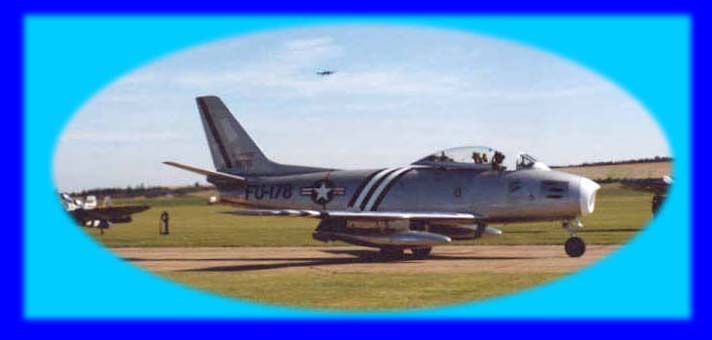 |
The North American F-86 Sabre was America's
first swept wing jet fighter. It first flew in October 1947. It
effectively replaced the piston-engined Mustang as the standard
small, agile air force fighter. It was capable of supersonic flight,
though in practice its top speed was normally about 650mph
(depending on version). Over 6,000 were built. They served with
great success in the Korean war. This
Sabre was at Duxford in 2004. |
 |
The North American F-100 Super Sabre owes
relatively little to the earlier design, but was a new, potent,
supersonic medium weight fighter. It first flew in May 1953. 2,300
were built, serving with many air forces worldwide.
This Danish air force F-100F two seat trainer
visited Yeovilton in 1980. |
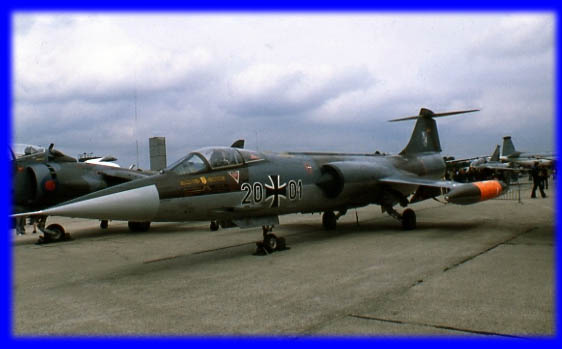
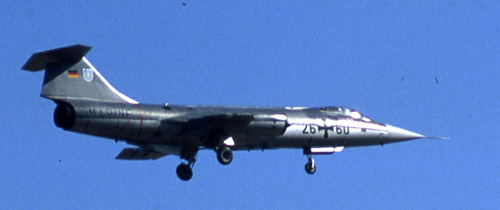 |
The Lockheed F-104 Starfighter epitomised the
trend in the late 1950s and 1960s for fighters to aim for speed at
the expense of everything else. It was essentially the smallest
aircraft that could be built round one J-79 jet. This gave it a top
speed of over twice the speed of sound, but with less armament than
the British Lightning and less agility than the Russian MiG-21. It
was also very noisy indeed. Nevertheless it scored considerable
export success.
Top: a German air force example at Greenham Common
in June 1979. Bottom: German Navy Starfighter flying at Yeovilton,
July 1986. (Without the tip tanks it must have had a phenomenally
short range). |
 |
The Republic F-105 Thunderchief was a large,
long range supersonic fighter-bomber. Over 800 were built. It first
flew in 1955, and some remained in service until the1980s.
This one visited Upper Heyford in August 1986. |
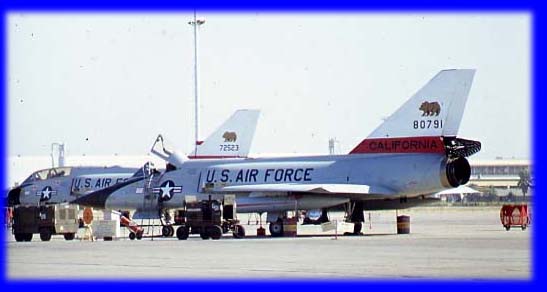 |
Convair recruited German designer Alexander
Lippisch (of Messerschmitt fame) after the war, and pursued his
ideas of delta winged fighters. The result was the F-106 Delta Dart
(a development of the earlier F-102), first flown in 1956. It was
capable of mach 2 and was a potent interceptor fighter.
This picture shows an F-106A with a two-seat
F-106B in the background, at Fresno in September 1981. |
|
|
The General Dynamics F-111 was the result of
a massive development effort over many years. The specification was
very difficult, effectively calling for a multi-role fighter and
attack aircraft capable of optimum performance over a very side
speed range. The solution was the innovative `swing-wing' design,
where the angle of sweep could be varied in flight to give the best
performance for the speed. This was heavy and expensive, but
effective. The aircraft was correspondingly massive. Other
innovations included a very neat twisting fold to retract the
undercarriage into a very tight space, and a crew escape system
whereby the entire cockpit could be detached from the aircraft and
descend by parachute.
The RAF nearly bought F-111s after the
cancellation of the TSR2, but were put off by the development delays
and the cost. They should have waited. In the end they were only
operated by America and Australia. 563 were built.
The top picture, showing three F-111Es with
wings at different angles, was taken at Upper Heyford in August
1986. The lower picture shows an F-111E at Mildenhall in the 1970s. |
|
|
The McDonnell Douglas F-4 Phantom has the
distinction of being the most widely produced jet fighter to date
with almost 5,200 built. It originated from the US Navy's McDonnell
F4H carrier borne heavy fighter, which first flew in May 1958. It
quickly became popular with air forces of many countries, proving
itself in both land and sea based roles. It is a multi-role
aircraft, mainly a fighter, but also serving in ground attack,
reconnaissance and electronic warfare missions.
The top picture shows an F-4C of the US Air Force
(Texas air national guard) visiting Upper Heyford in August 1986.
The middle picture is a Phantom FGR2 (a.k.a. F-4M), the version made
for the Royal Air Force after cancellation of their F-111 order, and
expensively (and unnecessarily) re-engined with Rolls-Royce Spey
engines instead of the American version's J79s. The lower picture is
an F4F of the German air force (Luftwaffe) at Fairford in July 2005. |
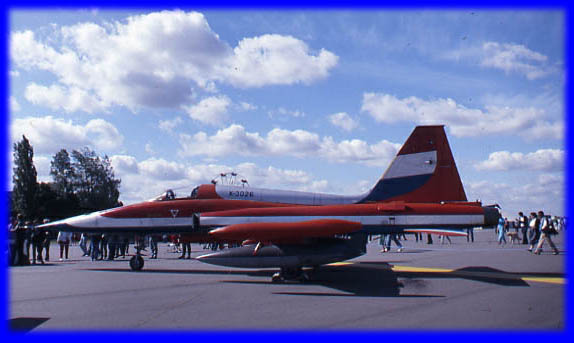
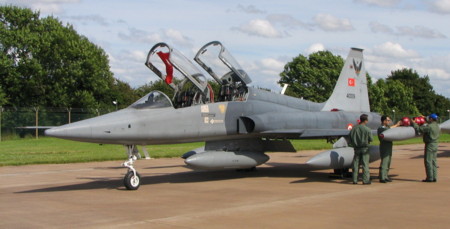 |
The Northrop F-5 Freedom Fighter is a
lightweight fighter, designed to complement the heavier F-4. It is a
very agile and capable aircraft, of which 1,500 have been built
since it first flew in 1959, but relatively few have been operated
by the US forces. Mostly, they have been exported.
This F-5A is technically an NF-5A, having been
assembled under license in Holland, and operated by the Koninglijke
Luchtmacht (Dutch Air Force). Painted in an anniversary colour
scheme, it visited Upper Heyford in August 1986.
Lower picture: Turkish air force F5B, Fairford,
July 2007. |
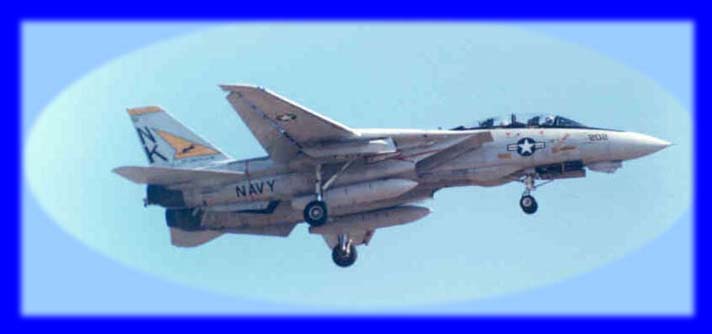 |
The Grumman F-14 Tomcat was designed for the
US Navy as a replacement for the F-4. One of a select band of
variable geometry (`swing-wing') aircraft, it has outstanding
performance over a very wide speed range. It is hard to believe that
it first flew as long ago as December 1970. 557 were built, mostly
for the US Navy. This one is seen
landing at NAS Miramar in 1988. |
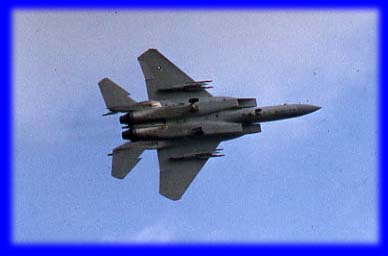 |
The McDonnell Douglas F-15 Eagle was designed
to a US Air Force specification similar to that which produced the
Navy's F-14. Not being constrained by the requirement to operate
from aircraft carriers, the F15 adopted a more conventional approach
which resulted in a very rugged and stable weapons platform. It
first flew in July 1972. It is in service with several air forces
including the US, Israel, Saudi Arabia and Japan.
This one is seen flying at Yeovilton in August
1984. |
|
|
The General Dynamics F-16 Fighting Falcon was
originally designed as a lightweight fighter, and first flew in
January 1974. It has since grown into a very capable multi-role
aircraft, used not only by the US air force but also by 16 other
countries. Over 2,300 have been built. its 23,450lb engine can
either be a Pratt & Whitney F-100 or a GE F110; either way, it has a
top speed of over 1,320mph and combat range of 600 miles. In its
later versions, it can carry up to 15,200lb of mixed stores
(missiles, fuel tanks, cluster bombs, laser guided bombs etc) on its
various external hardpoints.
Top: F-16A; lower: F-16B. Both operated by the
Danish air force & seen at Fairford in July 2005. |
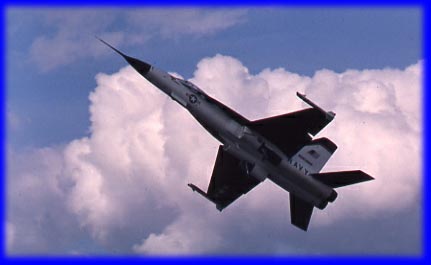 |
The Northrop YF-17 Cobra was the unsuccessful
competitor to the F-16 in the US Air Force lightweight fighter
competition in the mid 1970s.
Only the two prototypes were built. This one
displayed at an air show in England in 1976.
After the F-16 was selected as the winning
airframe, the F-17 design was bought by McDonnell Douglas, who
modified it substantially to produce the naval F-18 (below). |
|
|
The McDonnell Douglas F-18 Hornet was derived
from the earlier F-17, and became the standard lightweight fighter
for the US Navy. In its revised form, it first flew in September
1978. It proved very successful in its new role. 1,350 of the
initial variant were built, before the bigger and substantially
different F-18E supplanted them on the production line. They have
been exported to several countries worldwide.
Top: This Canadian CF-18 visited Yeovilton in July
1986. Bottom: two seat EF-18B operated by the Spanish air force, at
Fairford in July 2005. |
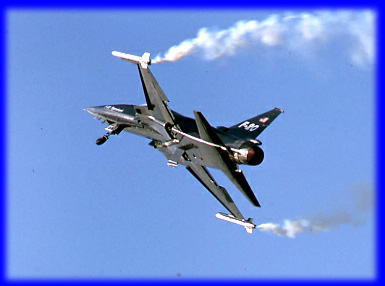 |
The Northrop F-20 Tigershark was a private
venture, high manoeuvrability update of Northrop's F-5 series. It
was a very capable aircraft, using the latest fly-by-wire technology
and an advanced single engine to replace the F-5's two ancient J85s.
Unfortunately the US armed forces had no
requirement for the type, and without the US as a customer no
foreign air forces were interested. No customers were obtained and
only the prototypes ever flew.
This F-20 put up a spirited display at
Farnborough in September 1984. |
 |
The Lockheed F-117 Nighthawk is one of the
most bizarre fighters ever produced. It uses radar-absorbent
material on its surfaces and `faceting' to reduce radar signature.
The air intakes are raked and blanked to prevent a radar seeing the
rotating parts of the engines. It was kept secret for many years,
despite persistent rumours of something called an `F-19' (a
designation which was never used). The true F-117 was revealed
publicly in the 1990s, by which time second-generation stealth
aircraft were being developed. This
F-117 was at Fairford in July 2007. |
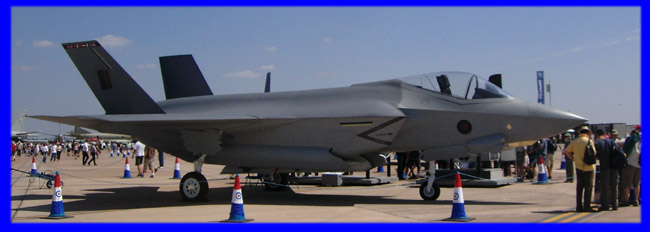 |
The F-35 Joint Strike Fighter is intended to
replace the F-16, early F-18s and the AV8B Harrier in service with
the US Air Force and Navy and the British Royal Air Force. It is a
short take-off and vertical landing (STOVL) machine, using a
shaft-driven lift fan rather than the Harrier's full vectored thrust
technology. Different versions are planned for the various services,
optimised to different mission profiles. For stealth (low radar
signature), most weaponry is carried internally on two stores
stations, but it also has six external hardpoints for a variety of
missiles or bombs including laser-guided and cluster weapons. Its
single P&W F-135 or GE/Rolls-Royce F-136 engine will give it a top
speed of Mach 1.5 and range of over 1,250 miles (depending on
version). The engineering prototype, known as X-35, first flew in
October 2000. It is due to enter service in 2011.
Engineering mock-up displayed at Fairford, July
2005. |





|